Dogwoods can grow into impressive shrubs and trees. They delight with their colorful autumn colors and some bear edible fruit. We present the versatile dogwood and give tips on planting and care.
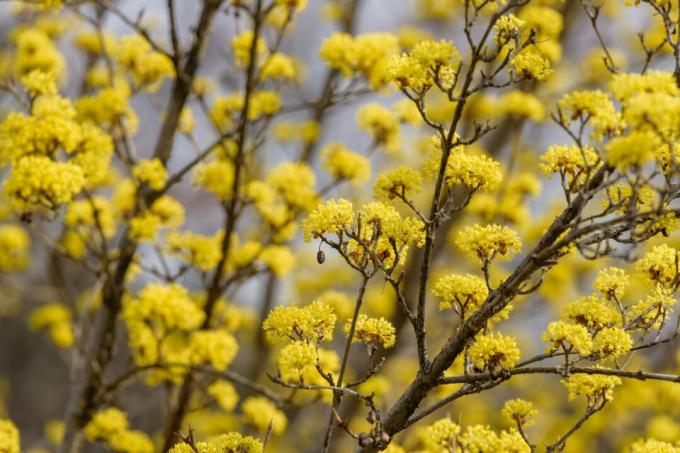
The Hardy Dogwood (Cornus) can be used in a variety of ways in garden design. We provide tips on planting, propagating and caring for dogwood.
contents
- Dogwood: origin and properties
-
Plant dogwood: location, planting time and more
- The right location for dogwood
- Planting procedure
-
The right care
- Fertilize and water
- Cut dogwood
- Common Dogwood Diseases
- Is Cornus hardy?
- Propagate Dogwood
- Is dogwood poisonous?
Dogwood: origin and properties
The dogwood, also known as horn bush, forms a genus within the dogwood family (Cornaceae). The hardy shrubs to small trees are mainly found in the temperate to sub-polar zones of the northern hemisphere. There they inhabit moist meadows, forests and shrub hedges. Numerous species come from North America or East Asia with a focus on Japan, Korea and China. Native dogwoods are the
cornel (Cornus mas) and the Crimson Dogwood (Cornus sanguinea).The perennial dogwoods usually grow into 2 to 6 m high and often just as wide, multi-stemmed shrubs, but there are also Cornus as a ground cover. With a few exceptions, the leaves of the dogwood are opposite on the shoots and are pointed and ovate to elliptical. Many deciduous species enrich the garden with bright autumn colors and striking yellow or red shoots. Some dogwoods are evergreen, such as the pagoda dogwood (Cornus controversa).
The flowers of the dogwood are in umbrella panicles or heads, often framed by large, white to pink colored bracts, the so-called bracts. But is the dogwood bee-friendly? Cornusspecies are among the nectar and pollen-rich flowering plants and are therefore often visited by bees and other insects. From the middle of summer the fruits of the dogwood ripen. These are single to compound drupes, most of which are edible. In the Asian flower dogwood (Cornus kousa) and the Cornelian cherry, these are used as high-yield wild fruit.
When does the dogwood bloom? Depending on the species, dogwoods flower very differently between February and August. In our article about Dogwood species and cultivars we give an overview of the most important species and their characteristics, such as growth height, flowering time and location requirements.

Plant dogwood: location, planting time and more
When planting dogwood, in addition to the choice of location, the correct procedure and the planting distance must be observed.
The right location for dogwood
Dogwoods prefer locations in full sun to partial shade, less often in the shade. However, the lower part of the trunk and the root area should always be well shaded, cool and moist. Most species thrive on fresh, well-drained and nutrient-rich soil with a neutral to slightly acidic pH value. Higher pH levels with calcareous soil only endure Cornus alba and Cornus sanguinea Good.
Planting procedure
Most dogwoods grow into stately shrubs or small trees. They are therefore more suitable for planting in beds and not for pot culture. Depending on the growth width, dogwoods should be planted in the garden at a distance of 3 to 6 m from other plants. A mulch layer or low underplanting of the solitary dogwood not only looks more natural, but also shades the root area and keeps the soil moist. Ground-covering perennials such as liverwort (hepatica), ivy (Hedera helix), catnip (Nepeta), purple bells (Heuchera) or elf flowers (epimedium). Dogwood is also popular when planted as a hedge, with dense, shrub-like plants with many shoots being suitable.
Low species such as the dwarf dogwood 'Kelseyi' or the creeping to ground-covering dogwood Cornus canadensis and Cornus suecica can, however, be cultivated in pots and planters. As forest dwellers, these two species prefer a rather acidic soil. Here we recommend our peat-reduced Plantura Organic Acid Soil, which can be used for planters or to create a bog bed in the garden. Some dogwoods, such as the cornelian cherry, can also be grown as bonsai.
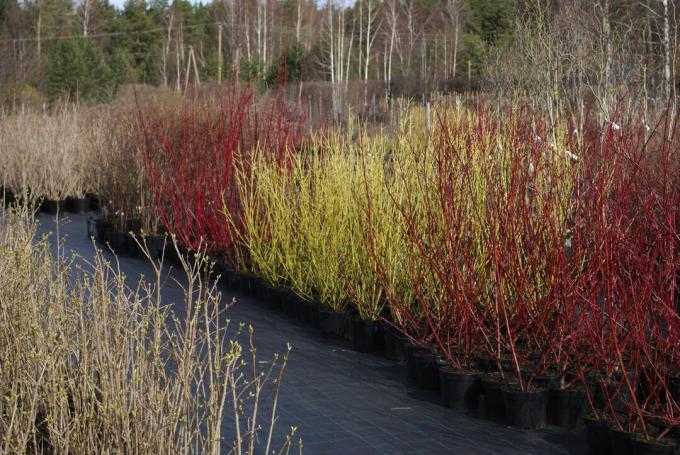
The optimal planting time for the dogwood is in the fall (between October and November) when the leaves have been shed. A freshly planted dogwood then primarily develops roots and can already show good growth the following year. Alternatively, you can plant in early spring, but in summer you have to pay particular attention to a good water supply.
At the future location, unwanted weeds should be removed before planting and the soil should be dug up and loosened over a large area. Poor soils can be enriched with mature compost in this step. Now a sufficiently large planting hole is dug, which is about twice as large as the root ball. Put the dogwood in, but no deeper than it was in the pot before, and fill in the planting hole with soil. The soil is slightly compacted all around and a watering rim is formed on larger shrubs and trees. In locations exposed to the wind, it may be necessary to attach a stake and coconut rope to keep the dogwood plants upright. Finally, water vigorously.
At a glance: planting dogwoods
- Species-dependent planting distance for solitary shrubs and trees, mostly between 3 - 6 m.
- Soil cultivation: Remove wild herbs, loosen large areas, work in organic matter if necessary.
- Dig a generous planting hole and put dogwoods in it.
- Fill with substrate, press down lightly and form the pouring rim.
- Tie large shrubs or trees to a stake and water.
- Underplant with low perennials or mulch to shade the root area.
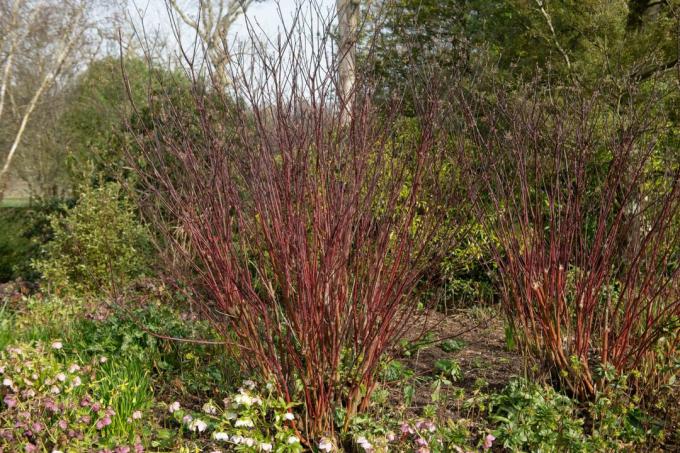
The right care
Dogwoods do not require any extraordinary care measures. We provide tips on pruning dogwood, water and nutrient supply.
Fertilize and water
Sufficient moisture and a good supply of nutrients are essential for vigorous dogwood plants. In hot, dry periods, it should be watered regularly if the dogwood has been planted in a bucket or has just been placed in the bed and has not yet been able to develop a deep root system.
Dogwood has a medium to high nutrient requirement. Fertilize dogwoods in spring when the leaves sprout, whether in pots or beds. A predominantly organic long-term fertilizer, like ours Plantura organic universal fertilizer, is ideal for maintenance fertilization. The animal-free, low-dust granules are simply scattered around the plant, gently worked in and watered. Soil organisms release the contained nutrients for the plant roots over the course of months, thereby preventing over-fertilization or leaching. For potted plants, the fertilizer granules can simply be mixed with fresh potting soil when repotting.
Cut dogwood
Many dogwoods are pruning tolerant and can be trimmed to shape regularly, which is especially important for hedging plants. Dogwood trees and large shrubs rarely need pruning. Here only dead, diseased or injured branches are removed. Cornus shrubs with colorful shoots, like Cornus alba, Cornus sericea or cornus sanguinea, can be pruned heavily every year, because only young shoots show the bright colors. The right time for pruning dogwoods is in early spring before the leaves sprout.
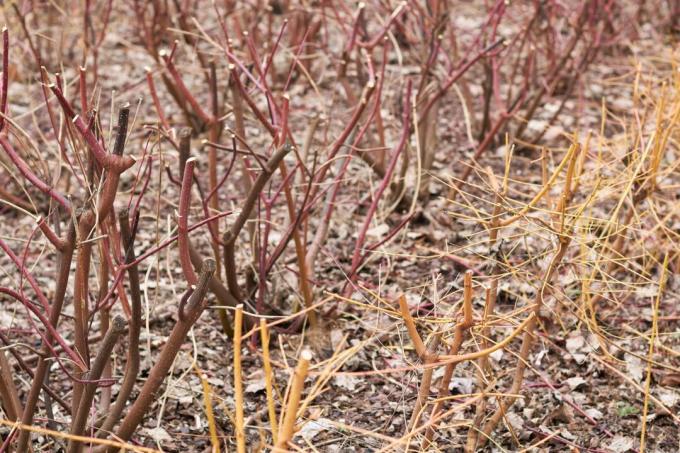
Common Dogwood Diseases
Dogwoods are generally hardy and are rarely attacked by disease or pests. Powdery mildew (Erysiphaceae) can appear on the leaves in unfavorable years. Root rot can develop if waterlogged. A suitable location before planting, a drainage layer and good water drainage in the planters prevent this. The common comma scale (Lepidosaphes ulmi) and the horse chestnut scale (Pulvinaria regalis) suck plant sap, which can lead to deformities and the death of young leaves and shoots. Only severe infestations require treatment - lice-eating beneficial insects usually take care of it.
A common disease in dogwoods is dogwood anthracnose from the fungus Discula destructive. Spots form on leaves and bracts from late spring, mostly from bottom to top. In addition, canker sores appear on the shoots and the bush may die off completely or partially. If diseased or damaged parts are cut out and disposed of immediately, the plants may be saved. Flowering dogwoods (Cornus florida) and Nuttall's dogwood (Cornus nuttallii).
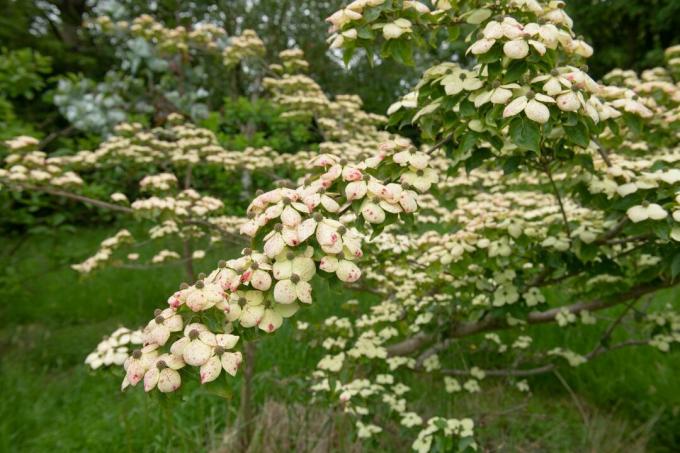
Is Cornus hardy?
Most dogwood species are reliably hardy down to below -20 °C and do not require any winter protection except in harsh winters. If the volume of soil is large enough, dogwoods in pots can overwinter outdoors and receive a protective insulating layer of jute or fleece to prevent the pot from freezing through. Bonsai trees, on the other hand, should always be overwintered frost-free. Late frosts in spring can damage sensitive species such as the flower dogwood. If there is a threat of icy temperatures, these shrubs or trees should be wrapped up well for a short time.

Propagate Dogwood
Dogwoods can be propagated by means of offshoots, cuttings and sticks. In summer the propagation by cuttings over the still soft shoot tips. In autumn, leafless sticks can be cut and rooted in a moist sand-soil mixture. Some species form runners that are cut off with a sharp spade and transplanted in autumn. Propagation is also possible through the dogwood seeds from the fruits. In order to get stately plants, however, several years must be planned. The seeds are cold germinator and therefore need a cold period of several weeks before germination.

Is dogwood poisonous?
In some species, such as the native blood-red dogwood, the bark, leaves and roots are classified as slightly poisonous. This applies to both humans and pets that eat the plants. For horses, on the other hand, the leaves of the dogwood are considered non-toxic. Dogwood foliage has tiny hairs that can cause allergic contact dermatitis on sensitive skin. It is therefore better to wear gloves when cutting the plants. However, the fruits of many dogwoods, especially cornel and fruit dogwood, can be eaten raw or processed.
A native wild and hedge plant that is often planted together with dogwood is the hawthorn (Crataegus). With us you will learn everything about properties, requirements and use.

